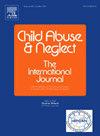积极童年经历对青少年不良童年经历与犯罪的缓冲作用:一项全国性研究
IF 3.4
2区 心理学
Q1 FAMILY STUDIES
引用次数: 0
摘要
虽然研究表明不良童年经历(ace)与青少年犯罪行为之间存在等级关系,但很少有研究调查积极童年经历(pce)是否在低风险样本中减轻了这种关系。目的探讨pce在高中生ace与自述犯罪行为和被捕之间的缓冲作用。参与者和背景数据是在2020年使用佛罗里达州青少年药物滥用调查(FYSAS)收集的,这是一项针对9-12年级学生的校内调查。在24,772名参与者中,51%报告其性别为男性,49%报告其种族/民族为白人/高加索人,30%报告其种族/民族为西班牙人/西班牙人/拉丁人,26%报告其黑人/非裔美国人,2%报告美国印第安人/美洲原住民,3%报告亚洲人,1%报告夏威夷原住民/太平洋岛民,3%报告其他种族/民族。方法青少年自我报告10例不良行为、8例不良行为、犯罪行为和逮捕情况。估计逻辑回归来评估在过去一年中被逮捕或在过去一年中犯下犯罪行为的影响。结果:ace每增加1分,骤停的发生率增加14%,pce每增加1分,骤停的发生率降低16%,没有证据表明pce对ace和骤停之间的联系有缓冲作用。ace分数每增加1分,犯罪几率就会增加13%,pce分数每增加1分,犯罪几率就会降低14%。ace与pce对不良行为有显著的交互作用。在ace较少的青少年中,pce对ace与犯罪之间的关系有较强的缓冲作用。结论:提高青少年即时环境中pce的干预策略对所有青少年(包括暴露于ace环境中的青少年)都有更好的效果。本文章由计算机程序翻译,如有差异,请以英文原文为准。
Buffering effects of positive childhood experiences on the association between adolescents' adverse childhood experiences and delinquency: A statewide study
Background
Although research demonstrates a graded relationship between adverse childhood experiences (ACEs) and delinquent behaviors for youth involved in juvenile justice, few studies have examined whether positive childhood experiences (PCEs) mitigate this relationship in low-risk samples.
Objective
This study investigates the degree to which PCEs buffer the relationship between high schoolers' ACEs and self-reported delinquent behavior and arrests.
Participants and setting
Data were collected in 2020 using the Florida Youth Substance Abuse Survey (FYSAS), an in-school survey of students in Grades 9–12. Of the 24,772 participants, 51 % reported their sex as male, 49 % reported their race/ethnicity as White/Caucasian, 30 % Spanish/Hispanic/Latiné, 26 % Black/African American, 2 % American Indian/Native American, 3 % Asian, 1 % Native Hawaiian/Pacific Islander, and 3 % another race/ethnicity.
Methods
Adolescents self-reported information on 10 ACEs, 8 PCEs, delinquent behavior, and arrest. Logistic regression was estimated to assess effects on having been arrested in the past year or having committed an act of delinquency in the past year.
Results
Odds of arrest were 14 % higher for every one-point increase in ACEs and 16 % lower for every one-point increase in PCEs with no evidence of a buffering effect of PCEs on the link between ACEs and arrest. Odds of delinquency were 13 % higher for every one-point increase in ACEs and 14 % lower for every one-point increase in PCEs. There was a significant interaction of ACEs and PCEs predicting delinquency. There was a stronger buffering effect of PCEs on the link between ACEs and delinquency among youth with fewer ACEs.
Conclusions
Results suggest intervention strategies that increase PCEs in adolescents' immediate environments promote better outcomes for all youth including those exposed to ACEs.
求助全文
通过发布文献求助,成功后即可免费获取论文全文。
去求助
来源期刊

Child Abuse & Neglect
Multiple-
CiteScore
7.40
自引率
10.40%
发文量
397
期刊介绍:
Official Publication of the International Society for Prevention of Child Abuse and Neglect. Child Abuse & Neglect The International Journal, provides an international, multidisciplinary forum on all aspects of child abuse and neglect, with special emphasis on prevention and treatment; the scope extends further to all those aspects of life which either favor or hinder child development. While contributions will primarily be from the fields of psychology, psychiatry, social work, medicine, nursing, law enforcement, legislature, education, and anthropology, the Journal encourages the concerned lay individual and child-oriented advocate organizations to contribute.
 求助内容:
求助内容: 应助结果提醒方式:
应助结果提醒方式:


